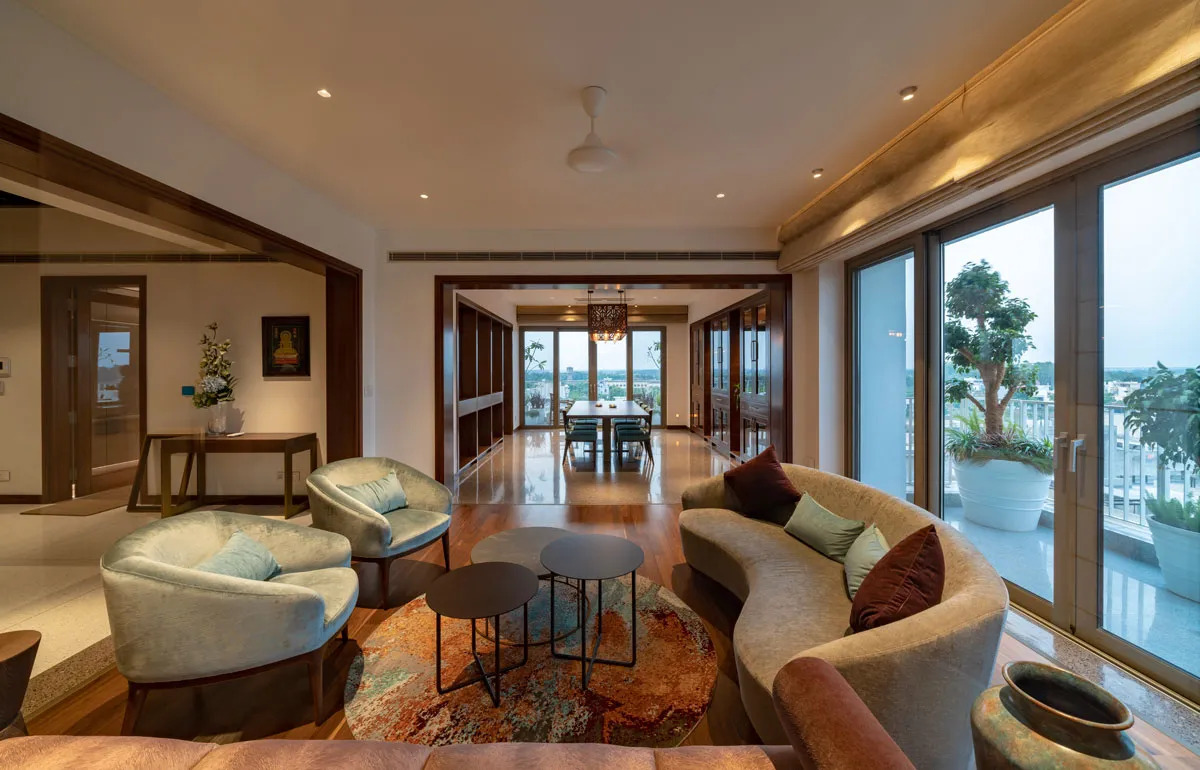Fenestrations aren’t just openings in a building, nor are they part of the background. With the right materiality and detailing, they become filters that set the tone, a powerful design element that influences light, air, sound, mood, movement and privacy, while meaningfully connecting inner and outer spaces.
Essentially, doors and windows are transitions and thinking of them so underscores their role in building design. “Good architecture pays attention to transitions,” says Meinathan N, Founder and Principal Architect, Architecture+Swath, and rightfully so. “The right height, the right frame, the right rhythm… they add up to spaces that feel generous without ever having to declare it.”
CW explores these frame options.
Brand options
Each fenestration brand has its own unique identity and, hence, is well suited for a certain application.
“Fenesta offers versatile uPVC and aluminium solutions ideal for contemporary residences, balancing durability, weather resistance and sleek aesthetics,” explains Nikhil Verma, Founder, Studio ADI. “Prominance stands out for its energy-efficient uPVC windows, perfect for urban homes seeking thermal and sound insulation with minimal upkeep. For high-end architectural projects, Schüco’s German-engineered aluminium systems provide slim profiles and expansive glass panels that exude luxury and precision. Japan’s Tostem brings minimalist elegance through its aluminium sliding and folding doors, creating seamless indoor-outdoor transitions.”
“Schüco and Tostem systems suit modern homes that call for clean lines and slim profiles,” says Sumit Dhawan, Founder, Cityspace ’82 Architects. “For luxury projects that require performance and customisation, Lingel and Fenesta offer excellent uPVC and aluminium solutions that achieve perfect insulation, durability and noise reduction.”
“We have used Artius for high-performance timber door and window systems that replicate traditional aesthetics while maintaining modern efficiency,” adds Anika Mittal Dhawan, Founder, Mold Design Studio. “For aluminium systems, we have worked with Schüco and Technal. Additionally, we have used Ducenick in select projects where uPVC was preferred, either due to specific requirements or budget constraints.”
“Brands like Tostem, Saint-Gobain, and Fenesta have become our trusted partners for consistently showing up with products that stand the test of time, with finishes and performance that elevate every space we work on,” says Saiharini Karthikeyan, Founder and Principal Architect, Architecture+Swath.
For residences in hot or composite climates, Vinod Singhi, Co-Founder & Principal Architect, Basics Architects, prefers high-performance uPVC or thermally broken aluminium systems from brands such as Fenesta, Lingel or Tostem.
“In our hospitality projects, we often use Schüco or AluK systems to achieve large spans with slim profiles,” he says. “For premium interiors, we use solid wood or engineered timber doors from Duro, Mikasa, or through custom joinery to bring warmth and a tactile, nature-connected feel. In high-traffic commercial spaces, powder-coated aluminium or laminate-finished flush doors provide durability with minimal maintenance.”
Speaking of hospitality and large-scale commercial architecture needing door and window systems that offer precision engineering, thermal efficiency and design versatility, Anil Badan, Founder, Studio B Architects, points out, “Schüco and Technal systems have robust aluminium profiles and tested performance, which make them very apt for large façades and expansive openings, especially in high-traffic zones, resort lobbies and curtainwall applications. Tostem is another preferred brand for sleek, minimal lines and superior surface finishes, especially in modern hospitality developments.”
While Badan’s choice is based on the scale, climatic conditions and operational demands of the project to ensure every opening simultaneously enhances experience and performance, Gaurav Sanghavi, Co-Founder & Principal Architect, Pentaspace Design Studio’s selection is guided by performance, aesthetics and context. “We have used brands such as Tostem, Schüco, Fenesta, to name a few, with the choice depending on the project typology, client requirements and budget,” he says. “For glass doors and partitions, we have used brands like Jebb Group, Bottomline and Kubik.”
Anika Dhawan cautions that certain materials have limitations in terms of available sizes, detailing and sustaining factor, which can influence the selection process.
Custom-crafted fenestrations
Notwithstanding the influx of branded systems, many projects feature doors and windows crafted to express a particular look and feel.
As Badan explains, “In premium villas or boutique properties, integrating custom-crafted metal and wooden systems, often developed in collaboration with specialised local fabricators, deliver a tactile, regionally grounded character while maintaining durability and precision.”
Custom-crafted solid wood doors finished with veneers or natural polish lend warmth and timeless appeal to projects with a natural aesthetic, according to Dhawan.
Most of Pentaspace’s projects use custom-made plywood or veneer doors fabricated by local contractors. “While brands like Greenply supply the base materials, the final product is usually bespoke, tailored to the design intent and project requirements,” explains Sanghavi.
Missing standards
Using standardised door and window systems would reduce the cost of this building element. But is this practically possible?
While commercial or developer-driven projects may lean toward standardisation to reduce costs, simplify and speed up procurement, and make replacement easier, Dhawan points out that in high-end residential projects doors and windows are seldom standardised, their dimensions determined by the façade rhythm, proportions and light requirements.
For instance, a luxury home might include 10-ft pivot doors or custom sliders across an entire wall, designed in partnership with the manufacturer.
Essentially, “doors and windows aren’t standard components but architectural tools tailored to evoke emotion and create experiences,” to quote Badan.
Agreeing that each project requires its own response based on orientation, façade design and privacy needs, Singhi explains that within a project, door and window heights are standardised to maintain visual harmony and make fabrication easier.
But this isn’t always possible.
In large-scale hospitality projects where the final dimensions are determined by the spatial scale, façade geometry and interior programme, Badan says a resort lobby may have 20-ft-high glazed panels to frame expansive views, while the guestroom windows are designed with controlled proportion to provide privacy and comfort. Different typologies within even the same development have different design responses.
While many developers loosely follow manufacturers’ common reference dimensions, in practice, Verma points out that each developer or architect adopts their own sizing grid based on aesthetics, ventilation, façade rhythm and product choice.
For larger residential or institutional developments, Singhi says defining a simple modular grid helps multiple vendors work together efficiently without compromising on precision or design consistency.
Architects enormously value the freedom to design. As Meinathan says, “We gravitate toward brands that give us freedom rather than confine us to standard dimensions.”
Most branded manufacturers support design freedom by offering custom sizing, configurations and various system selections. In many cases, developers work in close cooperation with architects and system suppliers to develop custom assemblies to meet structural, acoustic and climatic requirements.
Customised systems that can be fabricated to fit site-specific openings can accommodate slight variations due to construction tolerances and design intent, points out Verma.
A wide palette of possibilities makes it easier to design fenestrations that stand out.
Doors: Bigger is better
A door is not only a transition but also a threshold, or as Saiharini Karthikeyan, Founder and Principal Architect, Architecture+Swath, explains, “an invitation to experience space”.
In Architecture+Swath projects, Karthikeyan says, “We often push for door heights of 8 ft and beyond to give shape to our belief that every threshold in a home is an invitation to experience space, and we want that moment to feel intentional.”
“Even a subtle shift in proportion can transform how a space feels,” she says. “Suddenly the room breathes a little deeper, the light travels a little further, and the architecture gains a quiet sense of grandeur. It’s not about drama for the sake of it; it’s about elevating everyday movement through a home and making scale work in service of calm, elegance and openness.”
The 8-ft doors of Muruku Madras by Padmanabham, a 900 sq ft South Indian restaurant in Rajouri Garden, New Delhi, are in pinewood. With the aim of reinterpreting the essence of a South Indian home within a contemporary dining environment, this Studio ADI project’s façade is its defining gesture – a system of operable wooden shutters that transforms the glass frontage into a living threshold. Evoking verandas and carved doors of traditional homes, the shutters allow the restaurant to shift between quiet introspection and vibrant openness, mediating the flow between the public mall corridor and the private dining interior. Inside, arched teak-toned frames and layered materiality construct a tactile atmosphere.
Fenestration systems that allow architecture to breathe
For a residential project in Bengaluru, Architecture+Swath chose Saint-Gobain’s fenestration systems “because they allow the architecture to breathe”, explains Saiharini Karthikeyan, Founder and Principal Architect, Architecture+Swath. “The fenestration systems don’t just frame a view; they dissolve the boundary between inside and outside. Their glazing holds light beautifully, catching reflection and transparency in a way that shifts throughout the day. It turns something as functional as a window into a subtle moment of poetry, shaping the atmosphere rather than simply enclosing space.”
One residence, one theme – yet differently styled doors
A 10,900 sq ft residence in Sundar Nagar, Delhi, features differently styled doors, all of which integrate with the minimalist, classical material palette, exemplifying the narrative rooted in wood, light and artistry.
Their colour takes off from the soft contrasts, muted pastels and delicate textures scattered across the home. Glass-framed sliders, fully glass and partial glass doors, and large windows blur the boundary between inside and out, filling the living spaces with soft, natural light that amplifies the serene ambience.
“To ensure the residence feels like an intimate extension of the surrounding landscape, we included expansive openings and curated alignments that frame views as if each were a living painting,” says Gagandeep Dua, Architect, Workshop for Metropolitan Architecture (WMA).
“Luxury need not be loud, it can be quiet, enduring and deeply personal; an architectural narrative can transcend trends to achieve timelessness, that drove the choice of doors and windows and other aspects of Aviara,” says Bhuvan Kapila, Architect, Workshop for Metropolitan Architecture (WMA).
Quotes
Good architecture pays attention to transitions.
Meinathan N, Founder and Principal Architect, Architecture+Swath
In our hospitality projects, we often use Schüco or Aluk systems to achieve large spans with slim profiles.
Vinod Singhi, Co-Founder & Principal Architect, Basics Architects
For glass doors and partitions, we have used brands like Jebb Group, Bottomline and Kubik.
Gaurav Sanghavi, Co-Founder & Principal Architect, Pentaspace Design Studio
Doors and windows aren’t standard components but architectural tools tailored to evoke emotion and create experiences.
Anil Badan, Founder, Studio B Architects
Every threshold in a home is an invitation to experience space.
Saiharini Karthikeyan, Founder and Principal Architect, Architecture+Swath
Expansive openings and curated alignments frame views as if each were a living painting.
Gagandeep Dua, Architect, Workshop for Metropolitan Architecture (WMA)
An architectural narrative can transcend trends to achieve timelessness, and drive the choice of doors and windows and other aspects.
Bhuvan Kapila, Architect, Workshop for Metropolitan Architecture (WMA)
We have used Artius for high-performance timber door and window systems that replicate traditional aesthetics while maintaining modern efficiency.
Anika Mittal Dhawan, Founder, Mold Design Studio
Each developer or architect adopts their own sizing grid based on aesthetics, ventilation, façade rhythm and product choice.
Nikhil Verma, Founder, Studio ADI
Custom-crafted solid wood doors finished with veneers or natural polish lend warmth and timeless appeal with a natural aesthetic.
Sumit Dhawan, Founder, Cityspace ’82 Architects





















